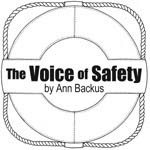EPIRBs: Register, Read, Train,
Test and Update
by Ann Backus, MS

The Electronic Position Indicator Radio Beacon (EPIRB) 406 MHz has made deployment of US Coast Guard personnel and “assets” to an incident more precise and rapid. The infrastructure around this electronic instrument is quite incredible and includes sophisticated satellites and electronics. The COSPAS-SARSAT organization is an international organization with members from Algeria to Vietnam. Their website www.cospas-sarsat.int contains a lot of interesting information. For example, there were more than 1,733,000 registered beacons around the world as of the end of Dec 2018.
This COSPAS-SARSAT system is a search and rescue (SAR) tool for aviation, maritime, and land incidents. The following table shows the distribution of events across the three types of geographic areas, the number of incidents and the number of people rescued. These data cover only one year, January-December 2018.
The effectiveness of the EPIRB and COSPAS-SARSAT system depends on proper operation and maintenance of the EPIRBs we have on our vessels. The first step is registration which is required for all EPIRB owners. Re-registration in the US is required every two years. The registration website is beaconregistration@noaa.gov. The second step is to read the manual carefully, train crew members in proper use, and to test the unit correctly and frequently. The third step is to update the registration information when the vessel is sold or otherwise out-of-service, or when the EPIRB is taken out of service.

Bringing this back to our District 1 data, the US Coast Guard District 1 EPIRB data show that in 2018 there were 25 inadvertent activations, of which 8 were the result of the owners throwing away the EPIRBs when their vessels were sold. In contrast in 2019, there were 19 inadvertent activations of which 3 resulted from EPIRBs that were thrown away. From a cursory look back at the EPIRB information for years back to 2015, it appears that in recent years there are fewer inadvertent activations due to careless disposal. That’s the good news. On the other hand there are recently proportionately more false activations which could be due to owner and/or crew being unfamiliar with how to test or maintain the units.
If we could reduce the false EPRIB activations in 2020, we could save the US Coast Guard and hence the US taxpayers considerable amounts of money…an amount per incident in excess of $30,000 according to estimates made by USCG District 17. So in addition to registering your EPIRB whether you are the initial owner or an owner by virtue of an F/V sale, it is important to read the user manual, train the crew on the use and testing of the unit, and follow instructions for proper replacement and disposal of batteries.
The COSPAR-SARSAT website suggests that batteries be removed from any unit prior to disposal and that the unit itself be labelled as “deactivated.” A part of the process of physical disposal the owner must contact NOAA and update the registration information. The phone is 1-888-212-SAVE (7283) and website beaconregistration@noaa.gov.
Finally, should an inadvertent activation occur, COSPAR-SARSAT recommends that the operator/owner turn off the EPIRB, shield it from the sky in a metal box (refrigerator?) and immediately call the registration number or a number on the unit or in the user manual. There is no penalty for calling-in a false activation, in fact, the call could save thousands of dollars in SAR funds and could avoid putting US Coast Guard and Good Samaritan fishermen at risk.
Given that 16 of the 19, 2019 false EPIRB activations were owner confirmed false alerts, let’s see if we can reduce the number of owner confirmed false activations in District 1 in 2020 by 50% this year – i.e., to fewer than 8.
As you get ready for another fishing season in the Northeast, re-familiarize yourself with the EPIRB unit and the user manual. I’ll check in with the 2020 data next year. Have a safe trip and stay healthy.
Ann Backus, MS is an Instructor in Occupational Health at Harvard School of Public Health, 665 Huntington Ave., Boston MA 02 5, 617-432-3327, abackus@hohp.harvard.edu.
